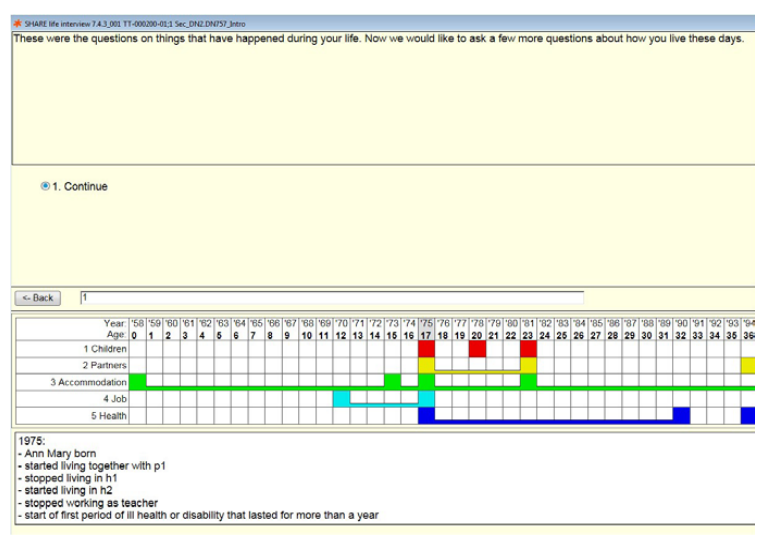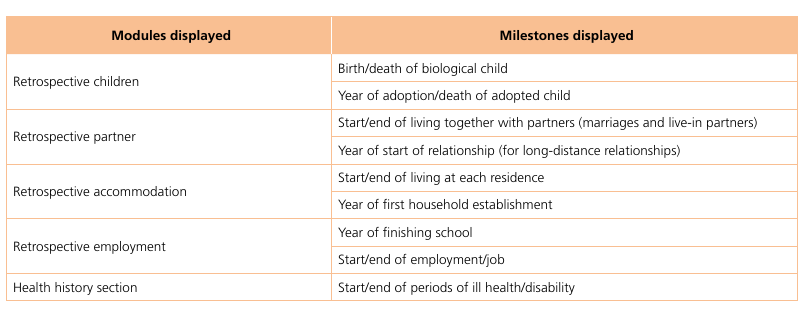SHARELIFE Life History
SHARELIFE data was collected in wave 3 and wave 7 focusing on respondents’ life histories. Most of the information collected in the regular SHARE waves is about the current life circumstances. As a result, we know little about what happened earlier in the respondents’ lives. SHARELIFE gathers more detailed information on important areas of our respondents’ lives, ranging from partners and children over housing and employment history to detailed questions on health and health care. SHARELIFE data complements the SHARE panel data by providing life history information to enhance our understanding of how early life experiences and events throughout life influence the circumstances of older people. With this variety SHARELIFE constitutes a unique cross-national, interdisciplinary database for research in the fields of sociology, economics, gerontology, and demography.
Collecting accurate retrospective information is a challenge. Respondents may not remember the occurrence or the exact timing of past events perfectly. Therefore, SHARELIFE follows a Life History Calendar (LHC) approach, which has been designed to help respondents in remembering past events more accurately. Using this method, the life events of interest are displayed on a “calendar”, enabling interviewers and respondents to cross-reference certain life-events with others (e.g. “I moved from A to B the year after my first child was born”). Using the life history calendar technique has been shown to improve the accuracy of the retrospective information given by respondents.
SHARELIFE – information about people’s life stories
The questioning method used in the SHARELIFE project is based on what is known as a Life History Calendar. The respondent’s life is graphically represented by a grid, which is automatically filled in during the interview.
The idea behind the LHC is to help the respondent remember by first asking about life events that they are likely to remember accurately. The interview usually begins with the names and dates of birth of the respondent’s children (and other information about them), followed by the history of their partners.
Once an event appears in the LHC, the interviewer can refer to it as an aid. For example, if the respondent is unsure of the date of a job change, it may be helpful to ask, “Was it before or after the birth of your second child?”
This principle applies to all other modules and is also flexible: respondents do not have to start with the module on children. If it is easier for them to remember another part of their life, they can start there.
Another aid provided by the LHC is a list of significant events for each year. If the respondent is unsure of the date, the interviewer can help by mentioning or verifying one of these events. For example, if the respondent cannot remember the year their child was born but knows that it was the same year as the occupation of Czechoslovakia in 1968, this information can help the interviewer determine the date.
In Wave 7, the SHARELIFE interview was administered to respondents for whom information on their life histories was still missing. This interview concerned all respondents from countries that joined SHARE after Wave 3 and respondents from “old countries” who were not interviewed in Wave 3, namely, new spouses and respondents from so-called refreshment samples. In total, SHARELIFE data from over 60,000 respondents from 27 countries were collected. This massive data source will be useful for researchers around the world. Respondents whose life histories were already collected in Wave 3 were asked the regular SHARE panel questionnaire (approximately 13,000 respondents).
SHARELIFE – life history calendar modules
The SHARELIFE history calendar records events into a grid, which spans across the respondent’s life course in years, time being the horizontal dimension. Table 2.1 is a tabular itemisation of the SHARE Wave 7 life history calendar, which displays different dimenions of a respondent’s life history:
- Information about the respondent’s offspring
- Information about partners
- Accommodation history
- Employment history
- Health history
The SHARELIFE interview in Wave 7 spanned various salient domains of a respondent’s life course:
-
The retrospective children questions collected retrospective information on children and deceased children, including information about pregnancies, births, adoptions, characteristics of children and maternity benefits and leave. The information obtained in these areas was contextualised by accompanying follow-up questions about employment and income at the instance of occurrence of certain salient events. For example, there were questions on income sources at the time of motherhood.
-
The retrospective partner questions collected retrospective information on all relationships until the present, including information on living arrangements, cohabitation, marriages, separation, divorces, and death of partners.
-
The retrospective accommodation questions collected information on past and current accommodations, including details of household establishment, residences (country, region), special accommodation events, moves, types of accommodation, cohabitation with parents/children, and ownership.
-
The retrospective employment questions collected data on employment spells, including information about employment status, job characteristics, income, retirement benefits, and employment after retirement. Data are also collected on work quality, job satisfaction, and career breaks due to ill health or disability, disability allowances, insurance and computer skills.
-
The retrospective health questions elicit information about health and healthcare history during both childhood and adulthood, including details about hospital stays, illnesses, injuries, diseases, vaccinations, doctor visits, preventive check-ups, health behaviours, reasons for not going to the doctor, forgone medication, and impact of financial situation on health care.
Information was also collected on childhood circumstances (e.g., childhood health, academic performance, relationship with parents, features of accommodation, books read, companions).
With respect to finances (e.g., insurance, housing, investments), information was collected on financial investments that the respondent may have made during his/her life, including investments in stocks or shares, mutual funds or managed investment accounts, life insurance uptake, business ownership, and overall household income (amount).
Information was also collected on general life events (e.g., periods of hunger, periods of happiness, stress, financial hardship, discrimination at work, respondent and parental experiences of persecution, oppression, and dispossession).

